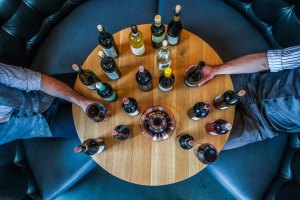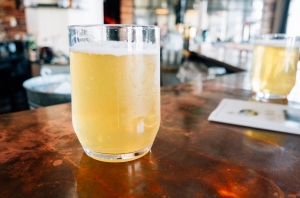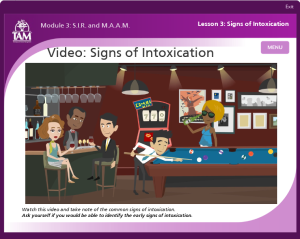 If you’ve taken your TAM® training, you know that a standard serving size for alcoholic beverages refers to 12 ounces of beer with 5% alcohol, 5 ounces of wine with 12% alcohol and 1.5 ounces of 80-proof spirits, which are 40% alcohol by volume. Knowledge of these standard serving sizes is very important, and can be helpful when you are observing patrons for increasing signs of intoxication. You can estimate how much alcohol they have consumed. However, it has become increasingly common for wine and beer to have a higher than standard amount of alcohol by volume.
If you’ve taken your TAM® training, you know that a standard serving size for alcoholic beverages refers to 12 ounces of beer with 5% alcohol, 5 ounces of wine with 12% alcohol and 1.5 ounces of 80-proof spirits, which are 40% alcohol by volume. Knowledge of these standard serving sizes is very important, and can be helpful when you are observing patrons for increasing signs of intoxication. You can estimate how much alcohol they have consumed. However, it has become increasingly common for wine and beer to have a higher than standard amount of alcohol by volume.
As reported by Health 24, it’s not uncommon for many wines to now register at 14-15% alcohol which throws off the standard five ounce serving. While a standard beer may register around 4-5% alcohol, the increasing number of microbrews and premium beers with higher alcohol content are also throwing a wrench into standard serving calculations. Finally, consumers can purchase flavored malt beverages which are packaged in bottles and sold at convenience, grocery and liquor stores across the United States. They can range anywhere from 5-12% alcohol depending on the choice. With all of these variations, it’s easy to see how patrons can easily consume more alcohol than intended. And, as a result, quickly become much more intoxicated.
Knowing this, servers, bartenders and anyone else responsible for service and sale of alcoholic beverages has a very important job on their hands… knowing how to spot an intoxicated guest, and knowing when to intervene or cut them off. As a server, it’s important to make sure that your guests are having an good time, are served exactly what they ordered, and remain respectful of the establishment and others without being over-served. What do bartenders and servers need to know, and how can they use this knowledge to provide responsible beverage service? Here are some tips to keep in mind.
- Read the labels and be knowledgeable about alcohol levels in the products you offer. If you have a bottle of wine or a beer on the menu with high alcohol content, it may be worthwhile to print the alcohol percentage on your menu, or at least be knowledgeable enough to answer guest questions about the alcohol content. A server can also politely mention the higher than average alcohol content to any guests ordering that beverage. A simple, “Here’s your beer. Just so you are aware, this particular bottle has a 10% alcohol level, so this is about double the standard alcohol serving,” would be appropriate.
- When serving and observing guests, don’t just consider a drink’s potency, consider the serving size as well. Even if you are serving a standard 5% alcohol beer to a guest, if they are ordering a 16 ounce pint glass instead of a 12 ounce bottle, then this is still delivering more alcohol than one standard single serving. As always, remain observant.
To learn more about safe beverage service and any warning signs to watch out for in patrons, take our alcohol awareness course and get TAM certified.

 Imagine this: you are serving beverages to customers, just like any other day. A younger couple visits your establishment and orders two pints of beer. You size them up and they seem sober and confident, but they look like they might be a little young. Think fast – what do you do? Ask to see I.D., or make the sale and send them on their way? If you chose option number two, you would have failed the test.
Imagine this: you are serving beverages to customers, just like any other day. A younger couple visits your establishment and orders two pints of beer. You size them up and they seem sober and confident, but they look like they might be a little young. Think fast – what do you do? Ask to see I.D., or make the sale and send them on their way? If you chose option number two, you would have failed the test. Every day, almost 30 people in the United States die in motor vehicle crashes that involve an alcohol-impaired driver. This amounts to one death every 50 minutes (
Every day, almost 30 people in the United States die in motor vehicle crashes that involve an alcohol-impaired driver. This amounts to one death every 50 minutes ( Late morning on a sunny Sunday, and who doesn’t love the idea of brunch? Offering brunch service is a great opportunity for restaurants to reach their client base and offer a unique selection of menu items and beverages. But remember, just because it’s the daylight hours, that doesn’t mean servers should be any less vigilant about safe beverage service. Bloody Marys and mimosas are standard brunch fare, and day drinking can still lead to over-intoxication. Here are a few tips that servers can keep in mind to help keep things safe, and make sure their customers still have a great experience.
Late morning on a sunny Sunday, and who doesn’t love the idea of brunch? Offering brunch service is a great opportunity for restaurants to reach their client base and offer a unique selection of menu items and beverages. But remember, just because it’s the daylight hours, that doesn’t mean servers should be any less vigilant about safe beverage service. Bloody Marys and mimosas are standard brunch fare, and day drinking can still lead to over-intoxication. Here are a few tips that servers can keep in mind to help keep things safe, and make sure their customers still have a great experience.